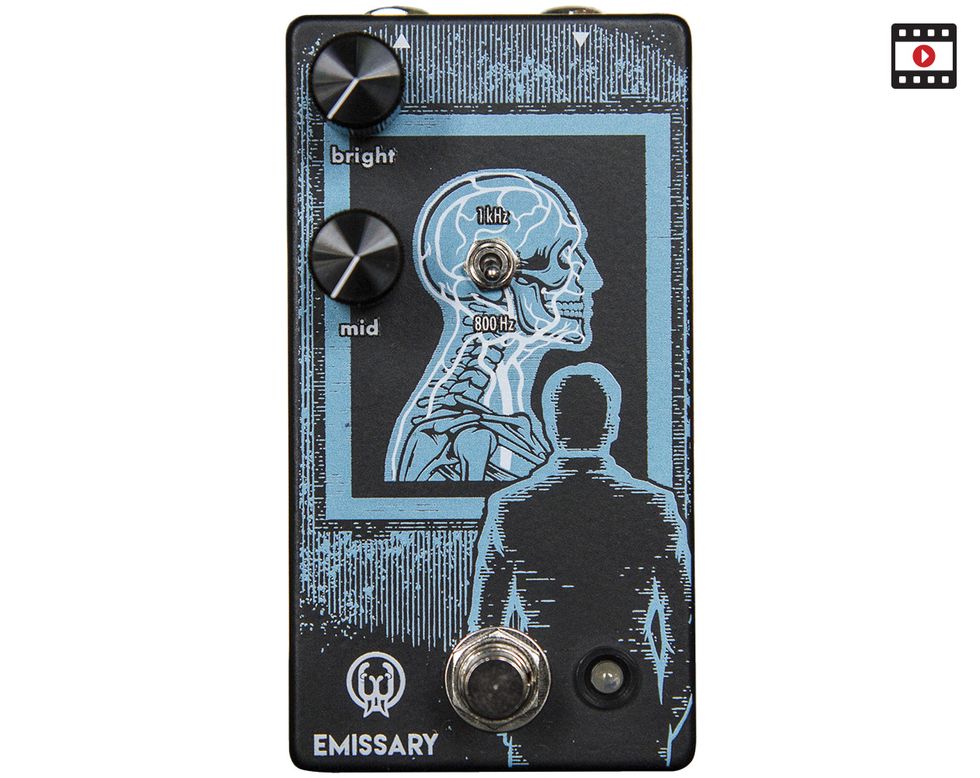0:00 – Pedal off
0:10 – Bright boost on 50%
0:23 – Mid boost on 50%, 800Hz setting
0:35 – …then 1kHz setting
0:47 – Both boosts on, 50% each (Mid on 1 kHz setting)
1:06 – Friedman on Lead channel – boost off, then…
1:10 – Boost on (both Treble and Mid, 50% each)
RatingsPros:A surprisingly versatile yet simple boost pedal—great for both nudging your tube amp into overdrive and helping solos cut through an already sizzling lead channel. Cons: It’s designed to enhance specific frequencies, so players seeking a totally linear clean boost might look elsewhere. Street: $169 Walrus Audio Emissary Parallel Boost walrusaudio.com | Tones: Ease of Use: Build/Design: Value: |
It’s amazing what varied forms the simple booster pedal can take. While many players just want to goose their amp’s front end in as uncolored a way as possible, many others have discovered that judicious goosing plus a little massaging of the sonic texture is often even more appealing.
That’s where Walrus Audio’s Emissary Parallel Boost pedal comes in. Rather than simply delivering traditional clean or linear boost that increases your guitar signal’s gain, the Emissary uses two differently flavored boost circuits in parallel, which you can dial in according to taste. The result is impressive versatility that belies the box’s two-knob simplicity.
Parallel Lines
The Emissary’s input splits your signal and sends it to two distinct, parallel booster paths. One is a clean, high-headroom JFET preamp voiced to emphasize high frequencies. The other is voiced to emphasize the midrange. A bright knob dials in the former, while a mid knob governs the latter. There’s also a mini-toggle that lets you select the band of midrange emphasis at 800 Hz or 1 kHz.
The on/off stomp switch is a soft-relay, non-latching type, which offers the bonus function of momentary operation so you can add a dose of boost for a quick passage and get back out without clicking twice. You just press and hold the switch to turn the pedal on, then release your foot to turn it off again. Normal stomp-on and stomp-off function is also available with a quick click of the switch.
The pedal runs on standard 9V DC power, and Walrus Audio recommends use of an isolated supply, rather than a daisy-chained power solution. The build quality is good, clean, and professional. The matte-black die-cast-aluminum box displays a graphic depicting some doctor-type chap viewing an X-ray of the inside of a patient’s head to view—a-ha!—the so-called “emissary veins” within the skull. I’m not sure we want to pummel those with boost too severely, but let’s plug in and find out.
Booster Club
Using a Gibson 1958 Les Paul reissue, a Novo Serus J with P-90s, a tweed Deluxe-style combo, and a Freidman Small Box head and 2x12 cab, the Emissary proved superb in several applications. It was entirely at home pushing the edge-of-breakup Deluxe into juicy solo mode. And the simple control set made it enjoyable for me to shape the frequency response of the output in the process. I enjoyed it even more as a solo sweetener with the Friedman’s hotter modified-plexi-like lead channel. It delivered superb lift and cutting clarity to lead lines, and felt and sounded natural as it drove the Friedman from beefy crunch to more saturated soloing mode.
The differently voiced parallel paths are an effective means of carving out boost tones in very specific ways. But while you can dial each of the boosts out entirely, I found myself less inclined to use one or the other individually. It’s most rewarding to find the sweet spot where the two channels coalesce into a perfect enhancement of the original signal. I can imagine occasions where the treble boost side alone could really liven up a dark guitar or amp, or where a notched midrange-only boost could chunk up a thin rig or add honk to solos or fat, ’70s-inspired rhythm parts. But Walrus Audio packed in two preamp paths for a reason, and the blend of the pair is where it’s at to my ears.
The Verdict
The Emissary offers exponentially greater voice crafting than traditional one-knob boosts. The extra EQ-shaping power is effective and thoughtfully applied while remaining dead easy to use. Rugged, with a low noise floor and excellent clarity and character all around, it’s definitely worth a listen if you’re shopping for a more versatile boost.
Watch the Review Demo:















![Rig Rundown: Russian Circles’ Mike Sullivan [2025]](https://www.premierguitar.com/media-library/youtube.jpg?id=62303631&width=1245&height=700&quality=70&coordinates=0%2C0%2C0%2C0)









